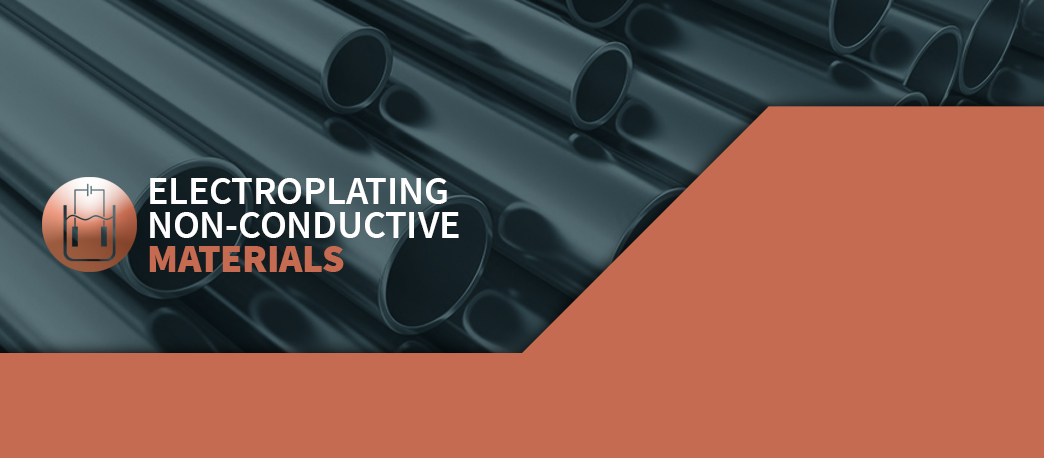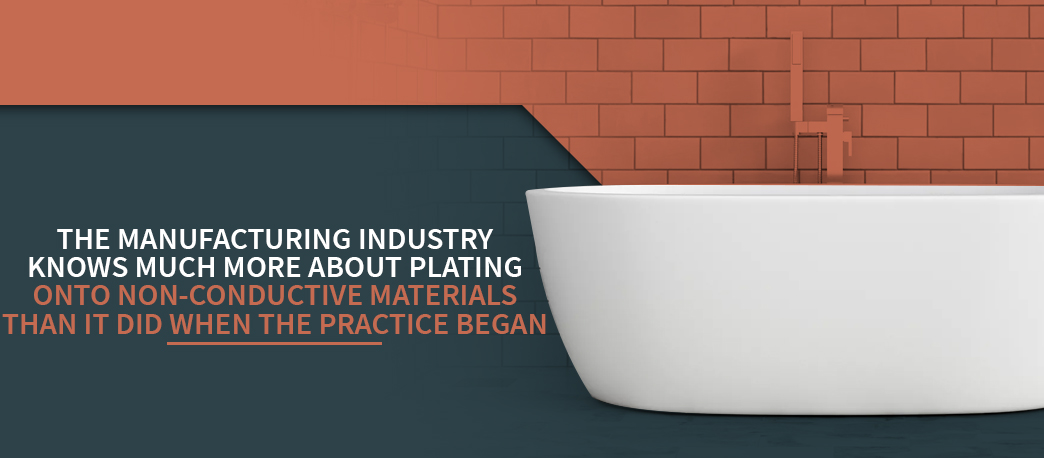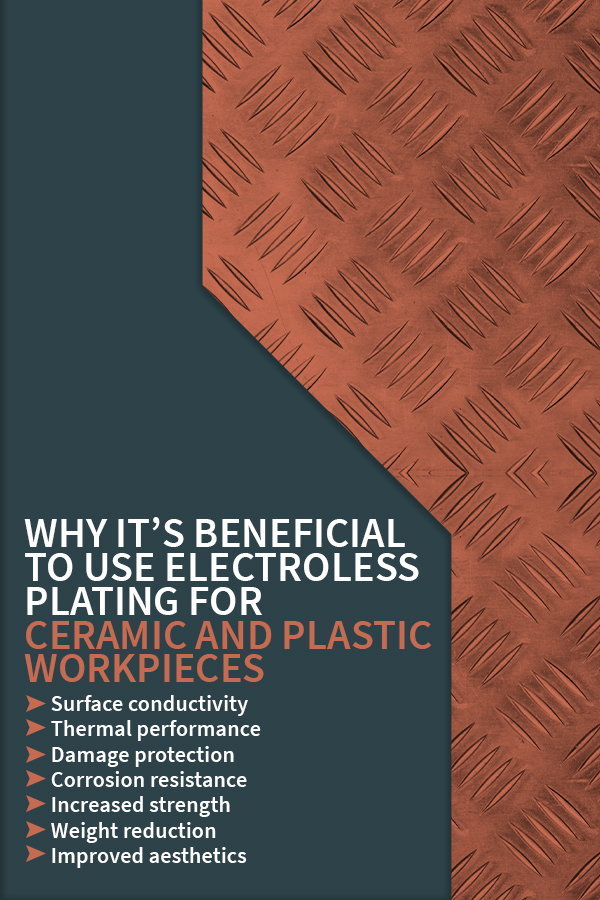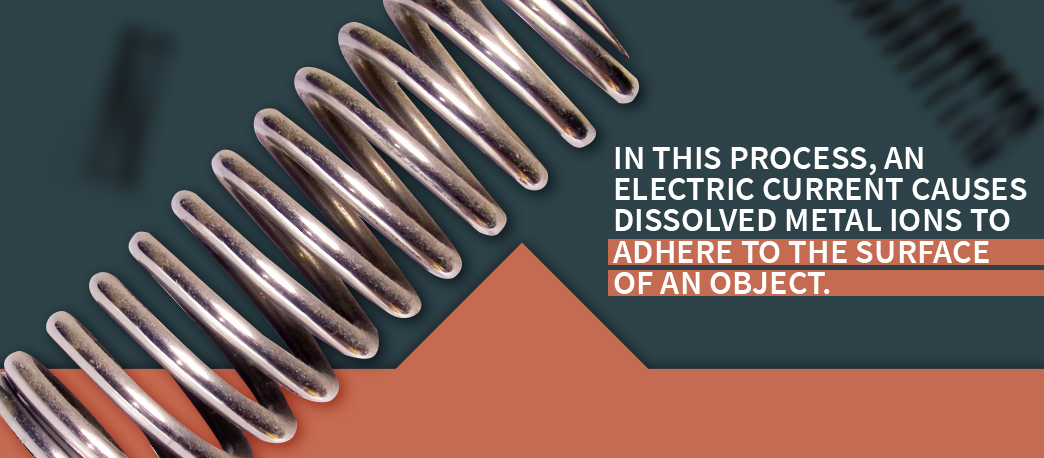Quick Links
What Are Non-Conductive Materials? | The Challenge of Plating Onto Ceramics and Plastics
Benefits of Electroless Plating | Electroless PLating | Using Electroplating to Complete the Process
Manufacturers in a wide variety of industries rely on electroplating to provide a finishing touch for their products. Electroplating offers several benefits for the final piece, including a strengthened surface, protection against corrosion, resistance against wear and an overall improvement in appearance.
If you’re familiar with electroplating, you probably know the method involves immersing the substrate in a chemical bath containing ions of a metal such as gold, copper, nickel or silver. Immediately following this process, the introduction of direct current applies the coating via electrodeposition.
In most cases, the plating process entails the application of a metal coating onto the surface of another metal object. These metals can conduct electricity, which is essential for facilitating adhesion of the coating. But what happens if you need to plate metal onto the surface of a non-conductive material?
What Are Non-Conductive Materials?
Non-conductive materials, also known as insulators, are materials that either prevent or block the flow of electrons. These materials exhibit this trait because the atoms inside these insulators do not contain the extra electrons needed to pass an electric charge — this makes it incredibly difficult to pass a charge through the material.
Some examples of non-conductive materials include paper, glass, rubber, porcelain, ceramic and plastic. Of these materials, glass, ceramic and plastic are standard throughout a variety of industries and are often plated with metal to alter their appearance and physical properties. Plated non-conductive materials are particularly popular within the following sectors.
- Automotive: The automotive industry uses quite a bit of electroplated non-conductive material, principally plated plastic. Plastic parts are easy to mold into nearly any shape and then plate, allowing automotive engineers more creative license in their designs without risking increasing the weight of their vehicles.
- Home fixtures: Plastic and ceramic fixtures are common in and around the home on everything from plumbing and electrical installations to handles and decorative items. While plain plastic or ceramic isn’t always the most appealing option, plated non-conductive materials offer greater aesthetic appeal while also providing benefits like improved wear resistance. Additionally, these products tend to be cheaper than their all-metal counterparts, meaning they are more competitively priced.
- Electronics: Plating is a standard procedure for the electronics industry, used in the construction of a variety of electronic components. Plating improves the appearance of plastic trim on personal electronics and also often gets applied to circuit boards and ceramic parts as a protective element.
You can also find plated non-conductive materials in several types of consumer products, including kitchenware, toiletries, bathroom items, clothing and even bottle caps.
The Challenge of Plating Onto Ceramics and Plastics
The manufacturing industry knows much more about plating onto non-conductive materials than it did when the practice began, and the process has continuously improved. However, it is still not unusual to run into problems when plating onto non-conductive materials. To ensure a high-quality outcome, it is essential to keep several factors in mind — most notable are factors related to the design of a product and the plating processes. These difficulties are below, with the most significant challenge by far listed first.
Non-conductive materials do not conduct electricity: While this is an obvious point addressed above, it’s essential to remember because it impacts the electroplating process. Because the substrate material cannot conduct electricity, it is functionally impossible to plate using the traditional electroplating process. As a result, the first layer deposited onto a part will need to get added using an electroless plating method. This step in itself is a challenge, because it significantly affects the handling of the product during the design and plating processes.
Design hurdles: One of the most significant difficulties associated with non-conductive material plating is designing a product for the plating process. Because you cannot plate non-conductive materials using an electric current, their design must account for electroless plating. To ensure the plating is successful, it’s crucial for a product design to include the following features and considerations.
- Wall thickness: The walls of the product should measure at 3.8 millimeters thick or less. Thicker walls allow for less airflow, which can lead to uneven cooling and cause the part to warp or shrink. Instead of thicker walls, ribs can add strength to the component, which provides the benefit of keeping the product weight low.
- Minimal variation: The cross-sectional dimensions of the product should be consistent throughout. Rather than designing a product with sharp edges, curves, corners and recesses, design it with gentle curves. Deep grooves can be difficult to reach, while sharp corners can result in plate buildup, or flash, which affects the final fit and appearance of the product.
- Easy draining: One of the most significant problems during the plating process is the entrapment of process chemicals. These chemicals used in the cleaning, rinsing or electroplating operations can get trapped in or on the product surface and leak out during a different stage, causing damage or preventing layer adhesion. To avoid this, design parts so they can drain more quickly — for example, if a design includes a blind hole, make it a through hole or make it larger to help with the liquid draining process.
- Design for ejection: For plastic parts, in particular, mold design is essential. It’s crucial to design the product mold so it is easy to eject the completed part without a mold release agent. Mold release agents, like silicon, can stick to the plastic surface and prevent the plating from adhering to the part. Instead of using such agents, taking simple steps like finishing the mold with a highly polished surface can make ejection easier without using problematic chemicals.
Plating challenges: While plating onto non-metallic materials such as ceramics and plastics offers many benefits, the process can be significantly more difficult than plating onto metal. Some of the most notable considerations to take into account in the plating of non-conductive materials include the following.
- Cleanliness: Ensuring the cleanliness of the substrate material is essential for a quality final product — contaminated surfaces can cause several problems with the plating, including poor adhesion and surface defects. To this end, the material gets chemically cleaned before plating, stripping exposed areas of surface contaminants using chemical baths. The substrate isn’t the only thing that must remain pristine, however — plastic molds, racks, baths and other equipment involved throughout the manufacturing and plating processes should stay clean to avoid the deposition of contaminants in and on the product.
- Draining: Draining and drying the product between each step is essential, which is why designing the product for draining is vital. Trapped chemicals can leak out during stages of the plating process, resulting in a low-quality plate or poor adhesion between plating layers.
- Drying: Moisture can also be an issue during plating — trapped pockets of moisture in plastic parts can lead to surface imperfections like blisters and splay.
- Warping and breaking: Non-conductive materials may warp or break at various stages of the plating process due to exposure to extreme temperatures or currents. Errors in handling may also result in these issues.
While these challenges are certainly different than the hurdles people face when plating conductive materials, they are relatively easy to overcome, especially when you work with a professional plating company that specializes in electroplating non-conductive materials and is familiar with the tricky aspects of the process.
Why It’s Beneficial to Use Electroless Plating for Ceramic and Plastic Workpieces
The implementation of electroless plating and a variety of additional steps makes plating onto ceramics more challenging than traditional “metal-on-metal” finishing. However, the extra effort can offer several valuable benefits for your product, and for your company as a whole. Some of the most common features and benefits sought with electroless plating include the following.
- Surface conductivity: In some electronics applications, an electrical current may need to pass along the surface of the part. Plating the non-conductive substrate with a conductive plating, like copper, will allow the product to carry this current. The ability to plate plastic with conductive plating has allowed electronics manufacturers to build lighter products, which has numerous applications for the automobile, aerospace and consumer electronics industries.
- Thermal performance: Several industries require parts to operate in high-temperature environments, or environments where the temperature cycles between hot and cold. Metal plating can protect a less thermally stable substrate from warping or breaking under these conditions, which is essential for automotive and aerospace applications.
- Damage protection: Metal is more durable than plastic or ceramic, and the addition of a metal plating to either substrate can help protect these products from damage. Metal is more resistant to wear from consistent use, which is helpful in the production of consumer products. It also has better surface hardness than plastic, making the product more difficult to break.
- Corrosion resistance: One of the most concerning forms of damage for plastic and ceramic parts is corrosion — plastic will corrode over time with exposure to certain chemicals and environmental factors, while some ceramics may be susceptible to corrosion from moisture. Corrosion-resistant metals, like gold and nickel, act as protective layers against this corrosion, effectively increasing the lifespan of the plated product.
- Increased strength: Depending on the specific material, non-corrosive substrates exhibit varying levels of hardness. Regardless of whether it’s ceramic or plastic, a metal coating can increase the hardness and strength of the product, enabling it to withstand heavy use over longer periods.
- Weight reduction: Plating metal onto sturdy, yet lightweight, materials is an easy way to produce functional, aesthetically appealing parts that are significantly lighter in weight than full metal components. As an example, plating onto plastic is a technique that has been common in the automotive industry since the 1960s as a way to reduce weight and improve fuel efficiency.
- Improved aesthetics: Plastics, ceramics and glass may not fit with the look of the larger product, or may themselves be dull or unappealing. A metal coating can add luster to the surface of the object, making it more attractive or helping it fit the desired appearance. Chrome plating plastic is a particularly popular form of this, especially in automotive applications.
The combination of these factors will result in higher-quality, better-looking ceramic products customers will be more willing to purchase — and reorder when the time comes. In a time when obtaining and keeping customers is more challenging than ever, plating onto ceramics can have a positive impact on a manufacturer’s revenues as well as what matters the most — the bottom line.
Using Electroless Plating to Coat Ceramic and Plastic Workpieces
The key to electroplating non-conductive materials is with a process called electroless plating. Unlike electroplating, which relies on depositing a thin layer of metal using an electric current, electroless plating deposits a light coating of metal without the use of electricity. Instead, the electroless plating process adheres the coating using an autocatalytic reaction. We’ll explain the steps in more detail below.
- Cleaning: Before applying any chemicals, the surface of the substrate must be clear of any oils, greases and particulates — any of these could interfere with the etching or plating process and result in a sub-standard coating. Typically, cleaning involves the application of several acids and bases, interspersed with several rinses to clear away any chemical residues.
- Etching: Once the surface of the material is clean, a procedure called etching prepares it for plating. In this process, the plastic or ceramic workpiece gets submerged in a chrome-sulfur etching solution, which eats away at the surface of the substrate. This process creates texture on the surface of the piece, which allows the metal to easily adhere to the substrate. After completing this step, you must clean the substrate thoroughly to neutralize any excess chromic acid.
- Electrolyte bath: The next step after etching is to immerse the object in an electrolyte bath of palladium and tin salts. The object then gets coated with an electroless plating solution of either nickel or copper. The palladium and tin salt solution acts as a catalyst, causing a reaction that forces the nickel or copper to form a thin coat on the substrate.
- Paint alternative: If you prefer a method other than the electrolyte bath, you can add a conductive paint to the surface of the substrate.
- Copper electroplating: Once the electroless layer is ready, a thin layer of copper metal gets electrodeposited on the surface of the workpiece.
Depending on the manufacturer’s requirements, electroless plating might be enough to provide the ideal finish for the product. However, it’s also possible to apply an electroplated top coat if desired, especially if there is a need to strengthen the surface or to enhance the final appearance of the workpiece.
Using Electroplating to Complete the Process
After the electroless plating process is complete, the surface of the substrate undergoes “metalizing,” which is the adhesion of a secondary coating through electroplating. In this process, an electric current causes dissolved metal ions to adhere to the surface of an object. While non-conductive materials cannot undergo this process due to their inability to carry an electric charge, ceramics and plastics that have gotten metalized with electroless plating can conduct electricity and are therefore able to undergo electroplating.
The process of electroplating metalized non-conductive materials is the same as electroplating a metal part — the substrate acts as a negatively charged electrode, while the metal of choice is the positively charged electrode. Both get submerged in an electrolyte bath, and an external electric current gets introduced to the system. The current oxidizes the metal atoms in the metal of choice, dissolving them into the electrolyte bath. These atoms then start to plate the substrate to the desired thickness. It’s possible to add multiple layers in this way.
Contact SPC to Learn More
Plating onto non-conductive materials can be a complicated process, with numerous factors to consider. However, it can be much more straightforward with an experienced plating company working with you.
At Sharretts Plating Company, we have over 90 years of metal finishing experience that we can use to help you achieve your goals. We have extensive expertise in electroless plating processes for non-conductive materials and have worked hard to perfect our techniques for electroplating plastic and ceramic materials. We’ll work with you to maximize your design and create a customized process tailored to your manufacturing needs.
Learn more today! Contact us for more information or fill out this form for a free, no-obligation quote.








